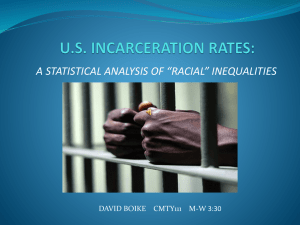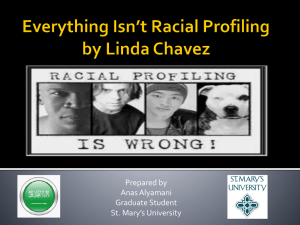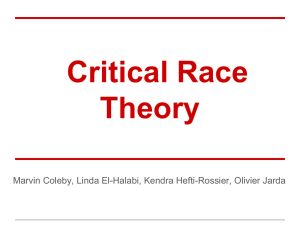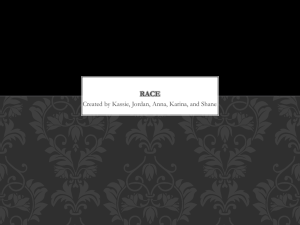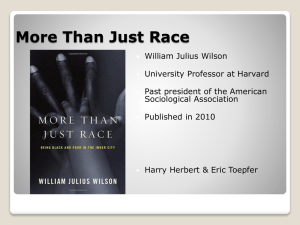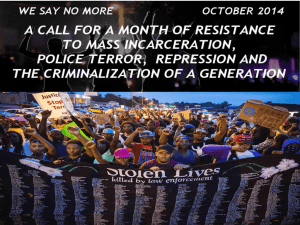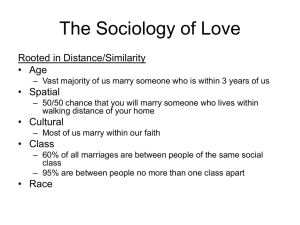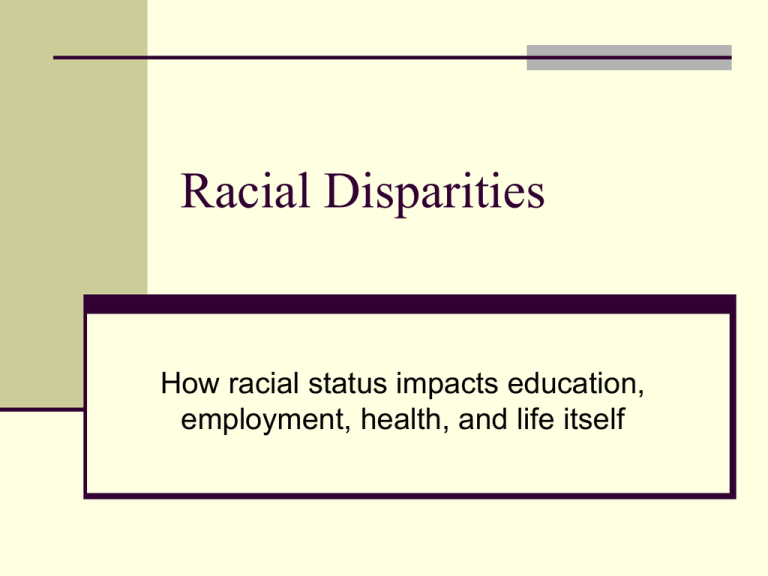
Racial Disparities
How racial status impacts education,
employment, health, and life itself
Race question (1990 Census)
7. Is this person of Spanish/Hispanic origin?
No
Yes: Circle one of the following: Mexican, Puerto Rican, Cuban, Other
Race question (2000 Census)
Current considerations
2000 Census Demographics, by race
2000 Census breakdown of the Asian American
and Pacific Islander population (total = 3.7%)
2000 Census breakdown of the Hispanic
American population (total = 12.5%)
Population shares
U.S. Racial Groups
Data from Cline Center for Democracy
Immigration Population: 1850-2009
Legal Immigration to the United States
Historical Census Statistics on the Foreign-Born Population
of the United States, 1970-2004; Current Population Survey
Foreign Born Concentrations in the U.S., 2000
U.S. population growth due to immigration
Population growth attributed to Non-Whites
Here’s Chicago
The New Face of America?
“There's not a Black America
and White America and
Latino America and Asian
America; there's the United
States of America.”
Barack Obama, 2004 Democratic
National Convention
Part III: Racial Disparities
• Education, Employment and Income
• Health Services
• Media Coverage
• Criminal Justice
• Life Expectancy
Education, Employment, and Income
More recent data
Latest College Graduate data from CFED
Recent data from Pew
Median Household Income by
Race and Educational Attainment
Average Family Liquid Retirement Savings
Estimated lifetime earnings by
race and education
Read the full Georgetown 2011 College Payoff report
Home Ownership by Race
U.S. Census, 2009
Latest home ownership
data from CFED
More racial economic
data and information is
available at the Center
for Community
Economic Development
website
Recent Pew Data
Unfair Lending Practices
from Center for Community Economic Development fact sheet
Bank lending practices (1991)
Economic data
Chicago Metro
Champaign/Urbana
Source: Diversitydata.org (compiled by Harvard University) http://diversitydata.sph.harvard.edu/Data/Profiles/Show.aspx?loc=308
Latest poverty rates data from CFED
Recent Pew Data
Health
Distribution lacking health insurance
by race and ethnicity (2004)
Latest
uninsured
data from
CFED
The higher uninsured rate for Hispanics is not associated with higher poverty
levels than other groups — the poverty rate for Hispanics is slightly lower than
for African-Americans, 22.2% vs. 24.9% respectively. Rather, research has
shown that Hispanics are more likely to be employed in jobs that do not offer
health insurance…but when offered health insurance they accept at the same
rates at whites and blacks (U.S. Department of Health and Human Services)
Institute of Medicine
2002 report on ethnic
and racial disparities in
health care
Race and Mental Health
Media Bias
Setting the national agenda
Media bias in coverage of Hurricane Katrina?
http://www.snopes.com/photos/katrina/looters.asp
The Criminal Justice system
A matter of opinion?
Sourcebook of Criminal Justice Statistics 2000, Table 2.29
“Driving While Black”
Black men are 35 percent more likely
than white men to report being
stopped by police for a traffic violation.
No difference between black and
white women in reported stops.
About 66% of blacks thought there
was a legitimate reason for the police
to stop their car, compared to 80% of
whites.
About 79% of blacks thought the
police acted properly during the traffic
stop, compared to 88% of whites.
Data from national sample of 7,034 people stopped by police in previous 12
months (Lundman and Kaufman, 2003)
LAPD Data: Police Stops
(Ayres and Borowsky, 2008)
The data show “prima facie evidence that African
Americans and Hispanics are over-stopped,
over-frisked, over-searched, and over-arrested.”
Specifically, when stopped by police, compared
to their White counterparts, Black drivers are
127% more likely to be frisked
76% more likely to have their vehicle searched
29% more likely to be arrested
LAPD Data: Search Outcomes
(Ayres and Borowsky, 2008)
Frisked African Americans are 42.3% less likely to be
found with a weapon and frisked Hispanics are
31.8% less likely to have a weapon than frisked nonHispanic Whites.
Consensual searches of Blacks are 37.0% less likely
to uncover weapons, 23.7% less likely to uncover
drugs and 25.4% less likely to uncover anything else.
Consensual searches of Hispanics similarly are
32.8% less likely to uncover weapons, 34.3% less
likely to uncover drugs and 12.3% less likely to
uncover anything else.
Ferguson Police Department Stopand-Search Statistics
“#Error” produced because it is not possible to calculate a percentage from zero.
Ferguson Police Department Stopand-Search Statistics
Racial Profiling: Illinois Data
Racial Profiling: Champaign-Urbana
Racial Profiling: University of Illinois
Racial Profiling: Illinois 6 YR Averages
U.S. Incarceration rate, 1925-2008
Data Source: Illinois
Department of Corrections.
(Graph: Prison Policy Initiative,
2010)
Sourcebook of Criminal Justice Statistics.
The Price of Justice
International Incarceration Rates
See complete world prison population list
World
Incarceration
Rates If
Every U.S.
State Were A
Country
Methodology and
formal citations
U.S. Incarceration Rates by Sex
Bureau of Justice Statistics, Correctional
Population in the United States, 2010, Appendix
Table 3.. (Graph: Peter Wagner, 2012)
Incarceration rates by race
Source: Statistics as of June 30, 2010
and December 31, 2010 from
Correctional Population in the United
States and from U.S. Census Summary
File 1.(Graph: Peter Wagner, 2012)
Source: Bureau of Justice Statistics,
Correctional Population in the United
States, 2010, Appendix Table 3.
(Graph: Peter Wagner, 2012)
Incarceration rates by race (cont.)
Source: Source: Bureau of Justice
Statistics, Correctional Population in the
United States, 2010, Appendix Table 3.
(Graph: Peter Wagner, 2012)
Juveniles in adult prisons
Racial disparities in Illinois
Nearly two thirds (64 percent) of the state's
45,629 prisoners in 2001 were AfricanAmerican, a percentage more than four
timers greater than blacks' share of Illinois'
population.
Incarceration rates since 1925
Mass Incarceration: The Whole Pie
Note: All cases are
reported only
under the most
serious offense.
For example, a
person who is
serving prison time
for both murder
and a drug offense
would be reported
only in the murder
portion of the
chart.
Incarceration vs Drug Use
A Closer Look at Marijuana
Read more here
A Closer Look at Marijuana
What happens when we decriminalize?
Massachusetts
decriminalized the
possession of small
amounts of marijuana
in 2009, and arrests
dropped an enormous
amount:
States that have legalized or
decriminalized marijuana to
date all have smaller-thanaverage black populations.
Thus, the benefits of these
policies have mainly accrued
to white smokers.
Where we are now:
Lifetime incarceration rates
Source: Bureau of Justice
Statistics, Prevalence of
Imprisonment in the U.S.
Population, 1974-2001.
Privatizing Prisons
Source: Private
Adult Correctional
Facility Census, 1995
and 2001 Editions.
Excerpt from The
Prison Index: Taking
the Pulse of the
Crime Control
Industry (2003) by
Peter Wagner
Federal Application of the Death Penalty
75% of those convicted of participating in a Federal drug enterprise
under the general provisions of SS 848 have been white and only
about 24% of the defendants have been black.
CapitalPunishment
Data Source: Bureau
of Justice Statistics,
Capital Punishment
2001, Spreadsheet
Figure 1. (Graph:
Peter Wagner, 2003)
Federal application of the death penalty
Bureau of Justice Statistics, Capital Punishment 2001, Spreadsheet Fig. 3
The abolition of the death penalty
No executions occurred in the U.S. between 1967 to 1976 (thanks
to efforts of the NAACP Legal Defense Fund).
Furman v. Georgia (1972): U.S. Supreme Court considers
constitutionality of the death penalty. Court divided…
Burger, Blackmun, Powell and Rehnquist argue in favor of
constitutionality.
Douglas and White argue that arbitrary application of capital
punishment is cruel and unusual.
Brennan and Marshall (and originally Stewart) argue that capital
punishment is itself “cruel and unusual punishment.”
White and Stewart make a deal
Furman v. Georgia: Dissent among abolitionists
“The discretion of judges and juries in imposing the death penalty enables the
penalty to be selectively applied, feeding prejudices against the accused if he
is poor and despised, and lacking political clout, or if he is a member of a
suspect and unpopular minority, and saving those who, by social position, may
be in a more protected position.” ~ Justice Douglas
"These death sentences are cruel and unusual in the same way that being
struck by lightning is cruel and unusual. For, of all the people convicted of
rapes and murders in 1967 and 1968, many just as reprehensible as these,
the petitioners are among a capriciously selected random handful upon whom
the sentence of death has in fact been imposed. My concurring Brothers have
demonstrated that, if any basis can be discerned for the selection of these few
to be sentenced to death, it is the constitutionally impermissible basis of
race…But racial discrimination has not been proved, and I put it to one side. I
simply conclude that the Eighth and Fourteenth Amendments cannot tolerate
the infliction of a sentence of death under legal systems that permit this unique
penalty to be so wantonly and so freakishly imposed.“ ~ Justice Stewart
The abolition and the aftermath
• Furman v. Georgia (1972) nullified the death
penalty (5-4) and converted the death sentences of
hundreds of death row inmates to life in prison.
• In following four years, 37 States enacted new
death penalty laws designed to overcome Court’s
concerns in Furman.
• Some of these new laws and constitutionality of
capital punishment upheld by Supreme Court in
Gregg v. Georgia (1976).
Race of victim in death penalty cases
•
In 1993 alone, 89% of the death sentences carried out involved white victims,
even though 50% of the homicides in this country have black victims (left)
•
Of the 1389 executions that have occurred since the death penalty was
reinstated in1976, only 20 have involved a white defendant for the murder of
a black person (info current as of 9-14-2014)
Race of Victims Since 1976
BLACK
LATINO
WHITE
OTHER
307
134
1550
44
14.9%
6.5%
76.3%
2.1%
Since 1930 nearly 90% of those executed for the
crime of rape in this country were African-Americans.
Currently, about 50% of those on the nation's death
rows are from minority populations representing 20%
of the country's population.
U.S. Dept. of Justice, Bureau of Justice Statistics
Collateral damage from the war on terror?
Criminal justice: Final thoughts…
"Even under the most sophisticated death penalty statutes, race
continues to play a major role in determining who shall live and who
shall die." ~ Justice Blackmun (1994, Callins v. Collins )
This is as true today as in 1994. Yet my guess is that many of you are
hearing about it for the first time. Of course, some of you have been
well aware of it for a long time. Out of necessity.
Recent Pew Data
But why do these racial discrepancies exist?
According to national surveys conducted by the
National Opinion Research Center (NORC), 66% of
Blacks but only 34% of Whites thought that racial
inequality in jobs, income, and housing was primarily
the result of discrimination (Schuman, Steeh, Bobo, &
Krysan, 1997).
A Christian Science Monitor/TIPP poll of 906 adults
taken from March 30 to April 5 found that twice as
many Blacks and Hispanics (73%) as Whites (36%)
say race played a major role in Trayvon Martin’s
death.
Remember the Sneetches?
Now the Star-bellied Sneetches had bellies with stars.
The Plain-bellied Sneetches had none upon thars.
The stars weren't so big; they were really quite small.
You would think such a thing wouldn't matter at all.
But because they had stars, all the Star-bellied Sneetches
would brag, "We're the best kind of Sneetch on the beaches."
Then one day, it seems, while the Plain-bellied Sneetches
were moping, just moping alone on the beaches,
sitting there, wishing their bellies had stars,
up zipped a stranger in the strangest of cars.
"My friends, " he announced in a voice clear and keen,
"My name is Sylvester McMonkey McBean.
I've heard of your troubles; I've heard you're unhappy.
But I can fix that; I'm the fix-it-up chappie.
I've come here to help you; I have what you need.
My prices are low, and I work with great speed,
and my work is one hundred per cent guaranteed."
A thought experiment…
So, how much money would it take?
for you to agree to a permanent race change?
and just so there’s something to compare to:
for you to agree to continue life as citizen of different
state?
for you to agree to not watch television for the rest of
your life?
A thought experiment…
Back to the thought experiment…
THE COST OF BEING BLACK: White Americans' Perceptions and the Question of Reparations
(Mazzocco, Brock, Olson & Banaji, 2006)
Back to the thought experiment…
THE COST OF BEING BLACK: White Americans' Perceptions and the Question of Reparations
(Mazzocco, Brock, Olson & Banaji, 2006)

